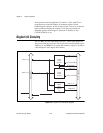
Chapter 3 Theory of Operation
©
National Instruments Corporation 3-17 AT-MIO-16X User Manual
The output voltage is available on the AT-MIO-16X I/O connector
DAC0 OUT and DAC1 OUT pins. The analog output of the DACs is
updated to reflect the loaded 16-bit digital code in one of the following
three ways:
• Immediately when the 16-bit code is written to the DACs
(in immediate update mode)
• When an active low pulse is detected on the TMRTRIG* signal
(in posted update mode)
• When the Update Register is strobed (in posted update mode)
Analog Output Configuration
The DAC output op-amps can be configured through one of the
AT-MIO-16X registers to generate either a unipolar voltage output or a
bipolar voltage output range. A unipolar output has an output voltage
range of 0 to +V
ref
- 1 LSB V and accepts straight binary input values.
A bipolar output has an output voltage range of –V
ref
to +V
ref
-1 LSB
V and accepts two’s complement input values. One LSB is the voltage
increment corresponding to an LSB change in the digital code word.
For unipolar output, 1 LSB = (V
ref
)/65,536. For bipolar output,
1LSB=(V
ref
)/32,768.
The voltage reference source for each DAC is selectable through one of
the AT-MIO-16X registers and can be supplied either externally at the
EXTREF input or internally. The external reference can be either a DC
or an AC signal. If an AC reference is applied, the analog output
channel acts as a signal attenuator, and the AC signal appears at the
output attenuated by the digital code divided by 65,536 for unipolar
output or 32,768 for bipolar output. The internal reference is a 5-V
reference multiplied by 2. Using the internal reference supplies an
output voltage range of 0 to 9.999847 V in steps of 152.6 µV for
unipolar output and an output voltage range of -10 to +9.999695 V in
steps of 305.2 µV for bipolar output. Gain calibration for the DACs
applies only to the internal reference, not the external reference. Offset
calibration can be applied to both references.
Analog Output Calibration
Output voltage accuracy is assured through the use of the onboard
calibration circuitry of the AT-MIO-16X. This circuitry uses a stable,
internal, +5 VDC reference that is measured at the factory against a
higher accuracy reference; then its value is permanently stored in the
EEPROM on the AT-MIO-16X. With this stored reference value, the


















